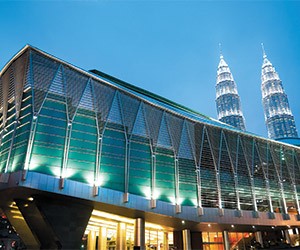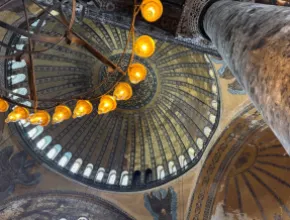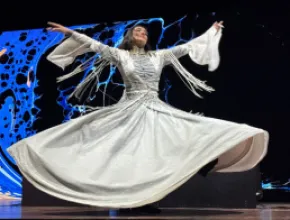Strategically located at the crossroads of Asia, Malaysia, which offers a fetching blend of Malay, Chinese and Indian cultures and myriad other ethnic groups, continues to see significant MICE growth—including from North American groups.
According to official statistics from the Malaysia Convention & Exhibition Bureau (MyCEB), North America accounts for a healthy 20 percent of total association conference leads, and 2 percent for corporate meetings and incentives. On average, North American groups comprise 350 attendees staying almost four days.
“Malaysia has improved by leaps and bounds in the business events industry, positioning itself as a top-of-mind preferred destination among North American event planners,” says MyCEB CEO Datuk Zulkefli Sharif. “Our wide-ranging offerings cover everything from award-winning convention centers to unique cultural experiences amalgamated from Asia’s oldest civilizations.”
From the capital of Kuala Lumpur to Kuching on the island of Borneo, host destination for the 2016 ICCA Congress this November, Malaysia’s value-driven meetings proposition is proving a strong and stable bet.
Buy the Numbers
Comprising Peninsular Malaysia (or West Malaysia, for simplicity, running between Thailand and Singapore) and the federal territories of Sarawak and Sabah on the island of Borneo (East Malaysia, across the South China Sea), Malaysia, established as a federation in 1963, balances ancient history with relative modernity.
Since MyCEB was created in 2009 by the Ministry of Tourism & Culture to strengthen Malaysia’s business tourism brand in the international MICE market, the country has experienced impressive meetings growth.
In the most recent International Congress and Convention Association (ICCA) rankings, released in May 2015, Malaysia rose five places to 30th in the world, and two places up to seventh in the Asia-Pacific region. Kuala Lumpur and Kuching also gained ground. The former went up five and two notches, respectively, to become 28th globally and eighth in the region, while the latter soared 35 places to reach 101st in the world, and eight places for 20th in the region.
Mirroring recent economic growth of around 5 percent annually, total arrivals for business events are also charting 5 percent year-on-year growth, accounting for 1,371,866 visitors in 2014.
Malaysia is aiming higher. In April 2016, MyCEB signed an exclusive one-year sales and marketing partnership with Malaysia Airlines to help drive business tourism and major events. Sharif, speaking at the signing ceremony, stated expectations of reaching 36 million tourist arrivals by 2020, along with his confidence in MyCEB “garnering at least 8 percent of that number for business events that it will support.”
As North American groups are discovering, confidence is a byword for meetings in Malaysia, where a maturing MICE infrastructure comes with a diverse and exciting product set.
New Heights
Completed in 1996, the 88-story Petronas Twin Towers gave Kuala Lumpur (locally, “KL”) and Malaysia an instant global identity. Though they have since been superseded as the world’s tallest skyscrapers, the towers, especially brilliant at night, remain symbols of KL’s rise as a world business tourism destination.
The same can be said for the city’s top MICE venue, the Kuala Lumpur Convention Centre.
“In just over a decade of operation, we have established ourselves as Malaysia’s premier facility and one of the leading meetings destinations in Asia-Pacific,” says General Manager Alan Pryor. “This can be attributed to our professional team’s successful delivery of flexible, innovative and value-add solutions to clients, in a well-maintained and world-class venue.”
PageBreak
Opened in 2005, the Centre sits in the heart of the Kuala Lumpur City Centre (KLCC), the 100-acre “city within a city” that includes the Twin Towers and group-accessible venues such as Petrosains, The Discovery Centre and Dewan Filharmonik Petronas, home to the renowned Malaysian Philharmonic Orchestra. Spanning five levels, the Centre offers more than 74,000 square feet of flexible function space, including 40,000-plus square feet of exhibition space, 3,000-person capacity Plenary Hall, and a grand ballroom for 2,000 guests.
The Centre commemorated its 10th anniversary by breaking ground on an expansion project, slated for completion by 2018, that will add another 32,800 square feet of flexible space to the facility. Other major KL venues include the MATRADE Exhibition & Convention Centre and Putra World Trade Centre; sprawling Malaysia Agro Exposition Park Serdang west of the KLCC; and Putrajaya International Convention Centre to the south. Alluring too, is the ancient Bukit Nanas Forest Recreational Park, or “Green Lung,” located in the heart of the city.
Value figures significantly in Malaysia’s appeal. According to the 2015 UBS Prices and Earnings Report, which ranks the relative cost of goods and services worldwide, KL prices at 41.2 percent against global leader New York City—meaning significant savings on hotels and other services. The city is amply supplied with more than 36,000 rooms, mixing international flags including Four Seasons, Hilton, Hyatt, InterContinental, Le Meridien, Mandarin Oriental, Marriott, Shangri-La and Sheraton with national brands.
Double Rewards
Malaysia’s distinct geography—comprising a peninsula and island divided by the South China Sea—adds exotic intrigue and compelling potential MICE destinations.
These include Kuching in the tropical, rain-forested southern Borneo state of Sarawak, host city for the 2016 ICCA Congress and its “gathering of the global ICCA tribes” theme.
As Mike Cannon, managing director of the Sarawak Convention Bureau states in an ICCA video, “we are an adventure destination with all the infrastructure, products and services that you need.”
Taking care of the latter are assets such as the Borneo Convention Centre Kuching and some 6,700 rooms ranging from three to five stars, while the former includes Gunung Mulu National Park, the world’s largest cave system. At Borneo’s northern tip in mountainous Sabah, groups will find another 6,000 four- and five-star rooms, mostly in Kota Kinabalu, where work continues on the Sabah International Convention Complex.
At the southern tip of Peninsular Malaysia just above Singapore, retail mecca Johor is home to the Persada Johor International Convention Centre, while Penang, an hour’s flight north of KL, is a Colonial-era gem boasting the dramatic Subterranean Penang International Convention & Exhibition Centre, or SPICE. Targeting completion by 2017, this visionary complex includes associated facilities such as the Setia SPICE Aquatic Centre and 10,000-seat Setia SPICE Arena. Plans also call for a 453-room business class hotel by 2019.
Penang is also home to Straits Quay Convention Centre, accommodating 120 standard exhibition booths, theater-style seating for 2,300 delegates and banquet space for 1,800 guests.
North of Penang lies Langkawi. Surrounded by turquoise waters and featuring UNESCO-protected mangroves and award-winning golf courses, this 99-plus island archipelago is home to the Mahsuri International Exhibition Centre and luxurious escapes such as the 91-room Four Seasons Resort Langkawi.







